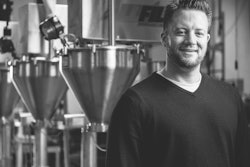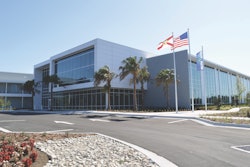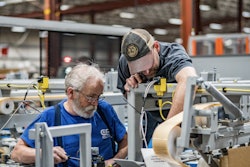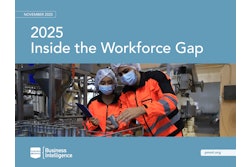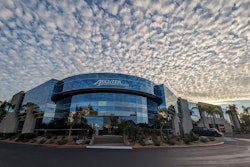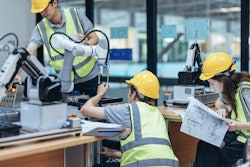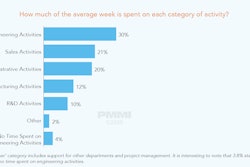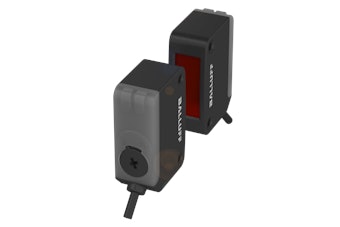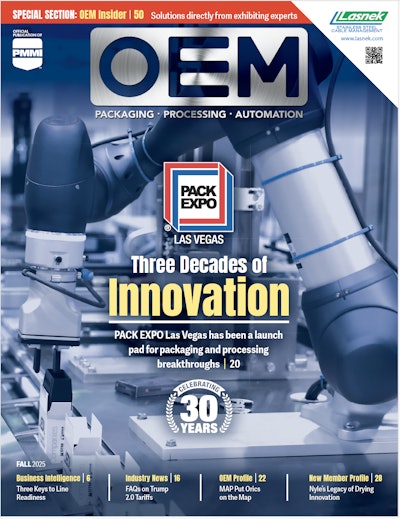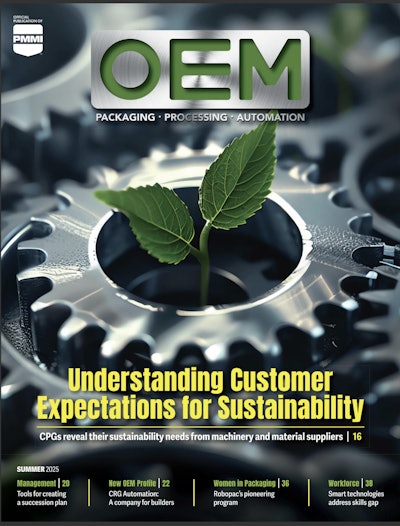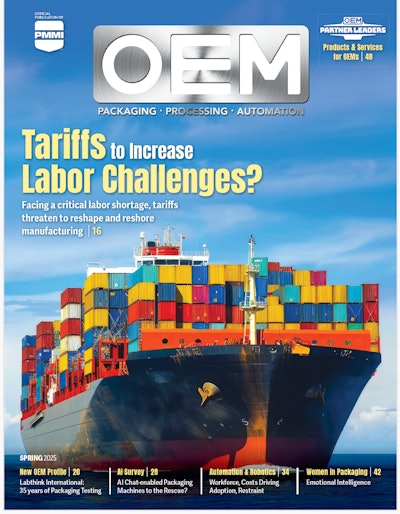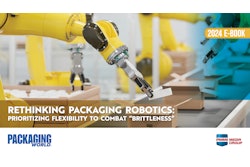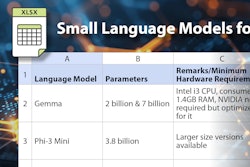While North American manufacturers have a strong demand for packaging and processing equipment, selling overseas may be an appealing option to every U.S.-based OEM at some point.
According to PMMI’s Taste of Processing Trends Around the World white paper, aside from the U.S., both Canada and India are expected to see strong sales growth and consumption in food and beverage over the next two-to-five years, sparking a rise in demand for processing equipment in those regions.
But where should North American OEMs shift their focus to first? PMMI’s vice president of market development Jorge Izquierdo says, “Take a look at Mexico, and see if it makes sense.”
Mexico could be an appealing option to machine builders who are looking to expand globally due to its close proximity to the states. And according to Izquierdo, Mexico ranks within the top five countries as a packaging machinery importer. So the demand and need for equipment is there.
“Selling into Mexico does require an understanding of the culture, as well as language capabilities,” Izquierdo says. “But American-made packaging machinery is very well accepted in Mexico.” In addition, PMMI has opportunities for OEMs to attend and exhibit at PMMI’s member event Expo Pack Guadalajara where there are chances to meet end users and agents who will tell you exactly what they are looking for, he says.
While Mexico may be low hanging fruit, there is currently a lot of mystery and concern around breaking into global markets—from rising tariffs to sending service personnel to remote or unsafe locations. Some builders wonder if the risk of selling into new regions is worth the profit, new customers and global presence.
OEM Magazine talked to North American machine builders, who have successfully waded into new regions, about the obstacles they faced, how they overcame them and what other OEMs should consider before going global.
Build a presence
For some OEMs, the first step to building a global brand is creating a presence in the region they are eyeing. Trade shows are a great way to enter into a new region, get an idea of equipment demands and meet potential customers, according to Justin Kirkpatrick, vice president of sales and marketing for Econocorp, based in Randolph, Mass. The manufacturer of economical case packing, cartoning and tray forming equipment, has always had an international presence, and currently sells into 111 countries. But Kirkpatrick is always looking at ways to get the manufacturer into new locations around the globe.
“Exhibiting at tradeshows internationally is an OK way to make a sale, but that is not our objective if we are trying to sell internationally,” Kirkpatrick says. “I think exhibiting at trade shows abroad is the most effective way to get exposure to other agents, distributors, partners and brands. You get the most bang for your buck if you go with the intention to get noticed by agents and distributors. You might get one sale, but the objective is to find those organizations that are going to sell your equipment in a region where you may not know the language or other factors that play into making a sale.”
If an OEM doesn’t have a physical location or presence in a region they wish to sell into, it’s critical to partner with distributors or sales agents who are well versed in that region. Kirkpatrick uses PMMI’s Sales Agent Directory to locate representatives both locally and globally and says it has helped Econocorp connect with agents before they’ve traveled to tradeshows.
“We are here in Boston, and our distributors and agents are all over world. It’s not as easy to get the mindshare that you are looking for, so you have to stay in contact with these people,” Kirkpatrick says. “There is certainly a lot of cost and time involved when expanding to global markets. You are talking about years and years of establishing relationships and showing them there is opportunity before you get a sale so it’s certainly a long game, but a worthwhile one.”
In addition to using PMMI’s International Sales Agent Directory, machine builders can research distributors that work in global markets. But Izquierdo says that OEMs should plan to put in time beyond researching and emailing.
“Machine builders send 20 emails to potential agents asking if they want to partner, but those agents get a lot of emails like that,” Izquierdo says. “You need to include a specific action or commitment like ‘I will be visiting, and would love to share our products with you.’ Treat agents like customers. You will have to compete for their attention.”
Once an OEM finds an international group or agent they are satisfied with, Kirkpatrick advises going to that group’s sales meeting and linking up with the other OEMs whose equipment they sell to find out what other global distributors they may be using.
Econocorp’s niche is selling economical machines to companies that are just getting started with machinery and automation, and many countries across the globe hold a lot of potential for the OEM. For example, South Africa is an emerging market where more industry is popping up, and there is a big demand for “starter” equipment.
But when it comes to international tradeshows, interpak in Germany is as about as important as it gets, Kirkpatrick says. Econocorp started off exhibiting in the U.S. pavilion at the show, and then branched off into its own booth on the floor, then came back to the U.S. pavilion to increase its visibility.
“Exhibiting with other U.S. exhibitors when you’re abroad is best because a lot of attendees are specifically searching out American companies,” Kirkpatrick says. “If your booth is randomly located on the show floor, you may miss that opportunity to be seen by attendees that are seeking out your exact solutions.”
While trade shows have been the popular, successful route to global markets for Econocorp, traveling to the shows and allocating equipment or materials to send can be costly. So the OEM decided to take advantage of PMMI’s International Trade Show Assistance Program.
“We had our own booth at ProPak Asia in Thailand, and we are currently exploring the idea of having a booth at Gulfood in Dubai,” Kirkpatrick says. “We also used the Trade Show Assistance Program a few years ago because we did a show in Nairobi, Kenya that PMMI put on with an Italian group.”
PMMI General Member companies that are exhibiting for the first time at qualified trade shows are eligible to get reimbursement for up to $5,000 in financial assistance from PMMI to apply toward the cost of floor space and booth decoration.
“We are now opening up the International Trade Show Assistance Program to tradeshows where we don’t have a pavilion, whereas before, PMMI had to have some kind of presence for member companies to use this program,” Izquierdo says “We wanted to make this more accessible.”
Aside from the PMMI’s International Trade Show Assistance Program, Econocorp is also tapping into local, federally-funded resources that help them expand. One of these programs being the Massachusetts State Trade Expansion Program (STEP), hosted by the Massachusetts Office of International Trade and Investment, in collaboration with the Massachusetts Small Business Development Center Network and the Massachusetts Export Center. STEP provides grants—capped at $12,000 per business—to eligible Massachusetts small businesses for the purpose of increasing export sales of their goods and services. It’s intended to help offset international business development and related marketing costs for businesses looking to expand globally.
This grant has helped Econocorp with its exports and sales efforts overseas, and Kirkpatrick encourages other OEMs to look into local and federally-funded programs that can help offset the cost of exporting and expanding international business.
Break ground
Once machine builders have made their presence known in a region they would like to sell into, depending on demand and how business is going, an OEM may want to open facilities around the world. While many manufacturers have been successful in transplanting a fraction of their operations overseas on their own, a more practical way to branch out may be through acquisition.
Five years ago, conveyor manufacturer Dorner had one facility in Wisconsin, and now the OEM has a global presence. It acquired companies in Germany, Malaysia and Mexico, and it also opened an office in Canada. Dorner determined that since it was doing well in the North American market, and reaching customers in Europe and Asia—but not to its full potential—it would expand globally through acquisition.
“All three of the acquisitions were a bit different,” says Stacy Johnson, marketing director for Dorner. “In Asia, we acquired one of our vendors for one of our product lines, so we were really trying to expand on that product line, give ourselves more capabilities, but also establish a presence in Asia, which gives us faster shipping and better customer service. When we were looking at Germany, our main focus on that acquisition was to get a footprint in Europe and get some kind of sales there with a more local group of people.”
In 2018, Kyoto Seisakusho Co., a 70-year-old system engineering company based in Japan, found it was imperative for them to acquire U.S.-based PMI Cartoning to find success selling into the North American space.
“There was a significant reason why we did not have a presence in North America,” Ken Nagasaka, PMI Kyoto’s corporate officer told OEM Magazine after the acquisition. “We strongly believe that the words, ‘made in the U.S.’ are going to be key if we want to serve the North American market. So, we had no desire to bring our product here, especially if it’s for the food industry, without a North American partner.”
PMI Cartoning also took this acquisition as an opportunity to expand into Asia, a region it had difficulty selling into in the past.
“There is an opportunity for us to learn from Kyoto and expand in that direction of the Asian market…their knowledge of the Asian market is really going to help us appeal to the Asian customer,” Branko Vukotic, president of PMI Kyoto told OEM Magazine. Read more about how PMI Kyoto handled explosive growth after the acquisition by visiting: oemgo.to/pmikyoto
While acquiring companies abroad may be an option for expanding globally, it may not be the most practical for the majority of PMMI member companies, according to Izquierdo.
“Acquisitions can be a great way to establish an international presence, but it’s also the most expensive way,” Izquierdo says. “More than 60 percent of PMMI members make less than 20 million in annual revenue. Chances are, they won’t be able to buy an international company or build an entirely separate office in another country.”
Create sustainable success
After OEMs have established a presence and got their footing in new regions, they need to figure out how to maximize their success and grow their reputation.
For Massman Automation Designs, LLC., the key to success when dealing in global markets is installing standard machines that rarely need servicing or maintenance.
“The strategy with highly engineered product is that you have to have a high degree of service to be able to support it,” says Jeff Bigger, President of Massman Automation Designs, LLC. “We are getting good traction with a highly standard product that, at one point in time, may have been a well-engineered product, but has since become more standardized. What’s good about that is that it’s a proven design, it doesn’t require a lot of after installation service, the machines startup easily and it doesn’t require much local service and support.”
Massman has seen great success with this strategy in Eastern Europe and South America. And because these machines don’t need much after installation service or support and don’t have downtime as often, Massman saves money on sending technicians across the globe and doesn’t have to worry about not having someone close by should a machine go down.
Another way Massman has successfully saturated a new region is by making sure its online and digital marketing efforts reflect what potential customers in foreign regions are looking for.
“We have developed and invested in more international marketing,” Bigger says. “Generating leads on the Internet has been pretty easy and it’s a good way to identify potential regions that may need our equipment.”
Similarly, one of the biggest projects Johnson undertook while Dorner was acquiring companies abroad was consolidating the brands’ marketing materials, while also translating their website into four different languages.
“We don’t sell every product that we have in every region, we only sell the lines that make sense in that area,” Johnson says. “By having the website accommodate and show that, we are not flooding customers with information that isn’t relevant to them. We want our website to feel like it was made for each specific region.”
It took Dorner two-to-three years to completely integrate the companies’ product lines and marketing materials, and it is still ongoing, which Johnson said are just some of the many hurdles of acquiring companies.
Aside from making the website translatable, it’s critical for OEMs to also learn the correct structure of words when it comes to including equipment keywords and making their website more searchable in different regions.
“You may already know what those keywords are in English, but make sure you know the translation of your equipment and how those regions are searching for it,” Izquierdo says. “While it may seem simple to use online translators, you should rely on a local or your agent in the region to give you the correct translation. The way words are ordered, even in the same language, the meaning can be completely different.”
Like many North American OEMs, Massman has some global customers, and selling internationally is the next big horizon for the company. However, Bigger still recognizes there is plenty of opportunities in North America as new markets and industries are born.
“If we are going to push and make more engineered products, then there is going to have to be a better plan,” Bigger says. “We will need to have more representation with our own service and support or with the help of a service organization, and it’s going to require more effort and analysis. We have been opportunistic on the international market side and a little more deliberate on [developing] new markets or taking market share in the U.S.”
With new industries and markets like cannabis, kombucha and craft beer becoming more popular, plenty of opportunities still exist for machine builders in the North American market.
Learn how technology suppliers and OEMs are partnering to adapt to sub-markets like craft beer and cannabis that need automated equipment: oemgo.to/submarkets
One size doesn’t fit all
Whether your company currently sells into different regions, or it’s in the middle of developing plans to go global, the key component to success is figuring out what makes sense to your company and its culture.
Analyzing market and regional trends is a critical component to figuring out which markets have high demand for packaging and processing solutions. Stay up-to-date on the latest industry reports that will reveal what regions OEMs should be eyeing.






